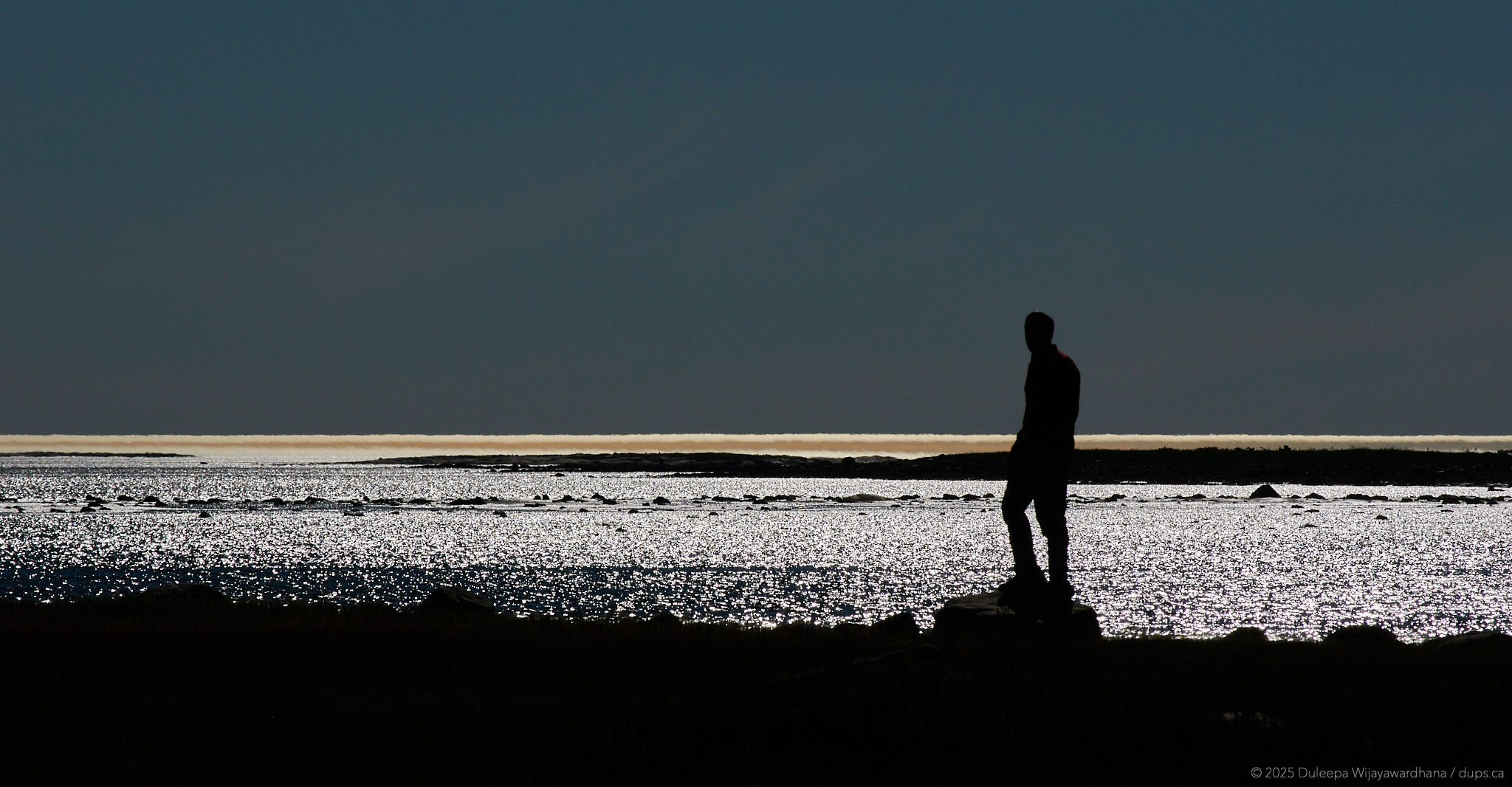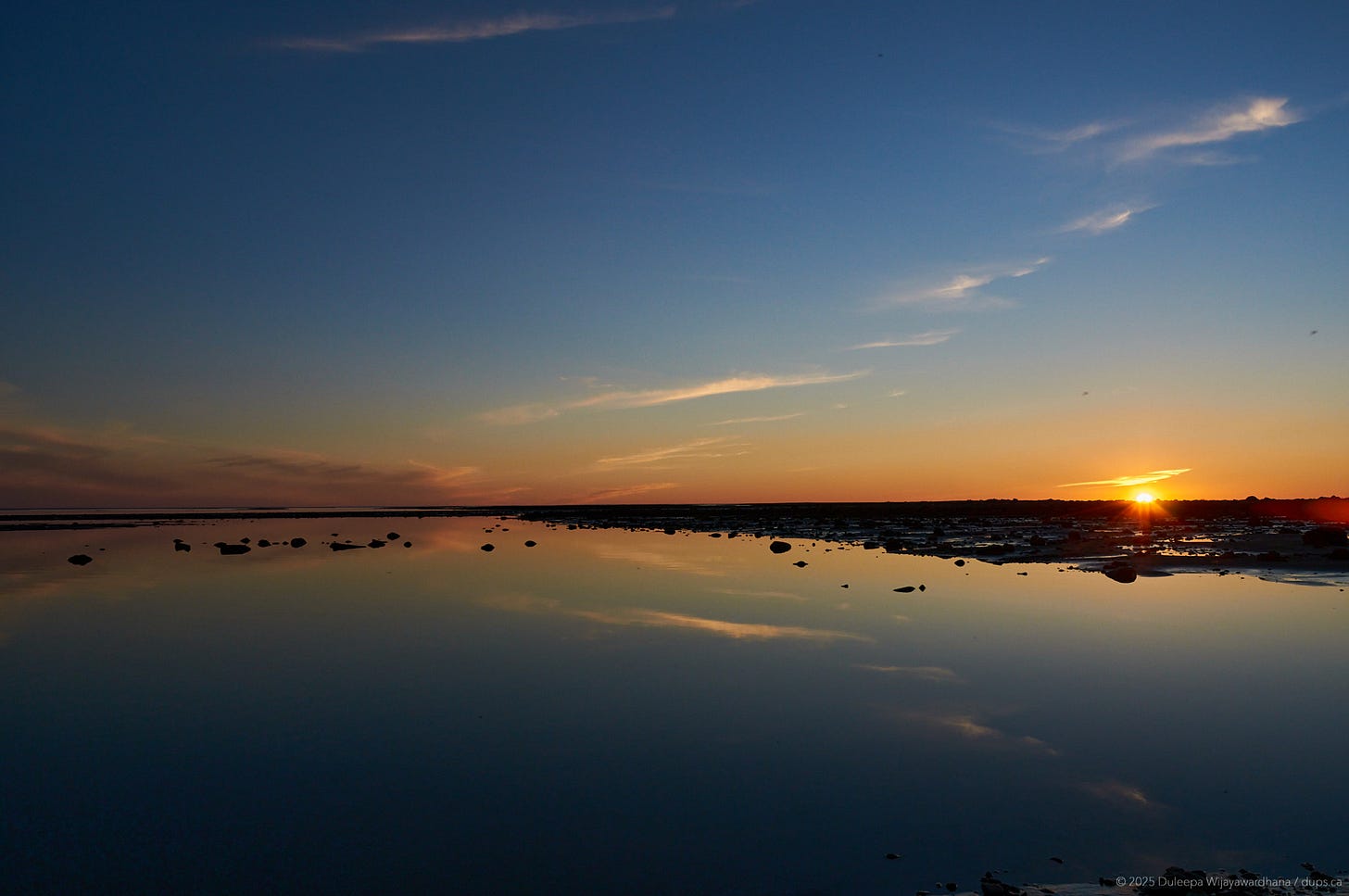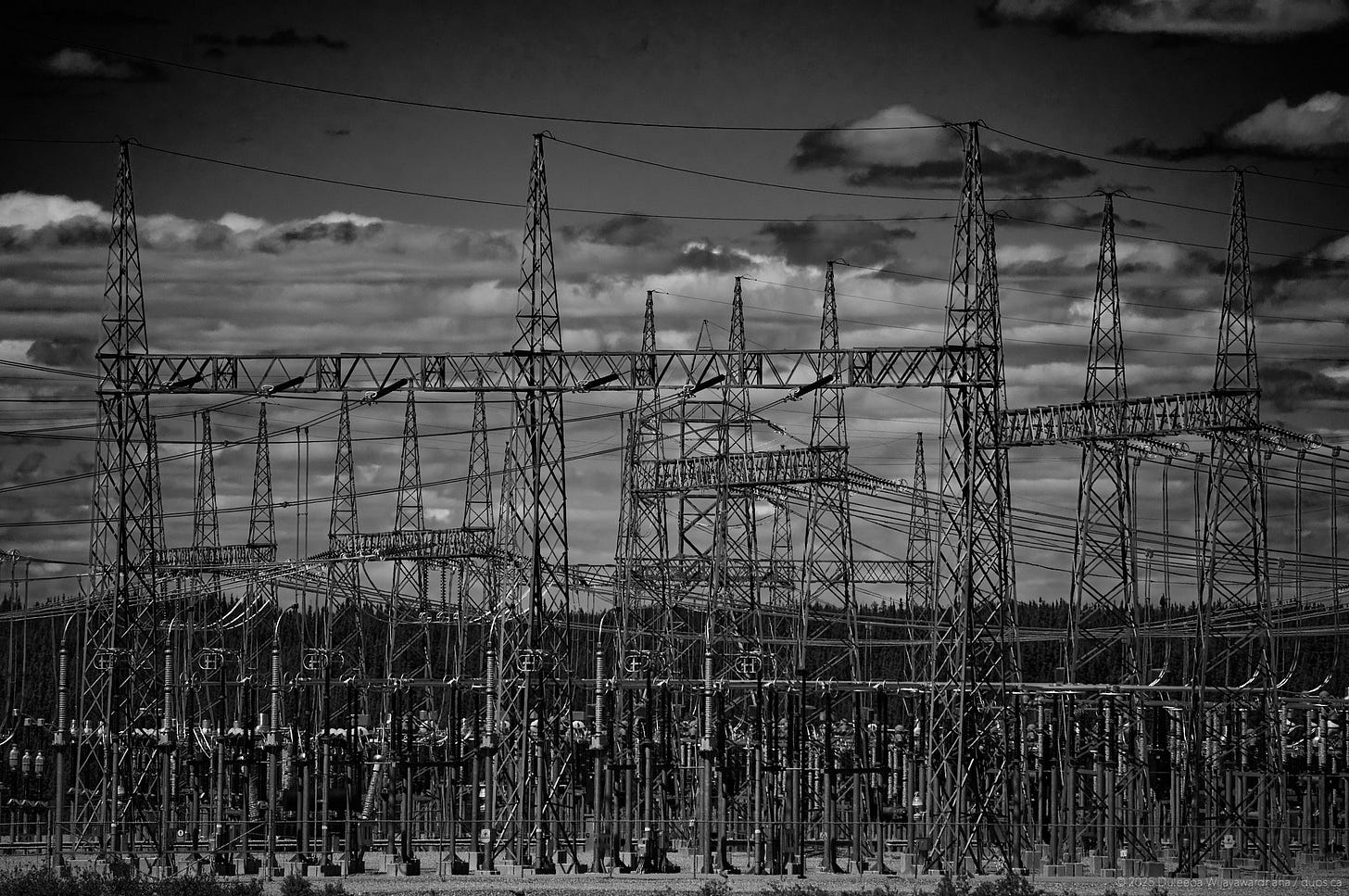Canoeing with elders under the grand dams of Hydro-Quebec
Part 2/2 – In 2008 my friends and I spend a day canoeing near Fort George and have a tour of the giant reservoir complexes changing the environments of northern Quebec.

You can listen to these journals from 2008 on Episode 9 of Tales under the cat tree podcast. View more photos on my photo gallery at photos.dups.ca
Read Part 1: To James Bay and the Arctic Ocean
June 27th. James Bay, the Arctic Ocean.
We’ve made it to the Arctic Ocean. Well, at least James Bay. To all the naysayers, I say, woo-hoo.
The day began ominously with the three of us by the side of the Rupert River staring at hundreds of mosquitoes lying in the netting of our tent. They were waiting. We were the bloodbags of their dreams, and I was the exotic Sri Lankan meat here. We ran out of the tent into bright blue skies and sunshine. I decided to do what Mike had done the previous day and brave the cold river to bathe. Believe me when I say it was cold. But I smelled less.
Breakfast done we entered the car only to find a literal thousand mosquitoes had taken residence. Lesson: Do not leave your car doors open while having breakfast. We hightailed it out of Rupert River with windows down and Mike and Gen bravely throwing or killing mosquitoes one by one. How long do mozzies live for? A few weeks? In which case there may be a few by the time we reach Montreal again.
Today’s journey saw some beautiful sights as we headed to Radisson. Sandy areas that look like desert, calm lakes, the gorge of Eastmain River. As we neared Radisson, the great hydroelectric projects of Hydro-Quebec became obvious. So much so that arriving in Radisson, we went to book a tour of the dams.
Our plan tonight is to sleep in Chissisibi, and if at all possible, by James Bay itself. With directions in hand, we headed to Chissisibi. I believe we were all hitting our breaking point of car inactivity. As the paved road ended and the gravel road began, the end, however, was within reach. After some tantalizing turns, we were at James Bay.
The wide bay spread luxuriantly ahead of us and we were met with a salt breeze and smell of algie. After securing our tent, we went tidal pool hopping and swimming in the Arctic Ocean. What we thought was paradise was infested with mozzies. I gamely cooked supper while mozzies tried to find a centimeter along my arm with space to suck blood from. Jen kindly gave me one of her mozzie head nets while we waited for sunset, which was one of the most beautiful I have ever seen.
Tomorrow, we canoe with Sherman.
Canoeing with Sherman and exploring Fort George
June 28, 2008. James Bay, Quebec.
If I thought yesterday was a highlight, today eclipsed it.
I’ve written journal entries in some odd places: in the middle of a field of goats in Siberia, and in a camp delirious with sickness in Tanzania, to name but two. This ranks right up there.
Currently, I’m sitting in James Bay itself, on a rock, in a mudflat, at extreme low tide. The sun is setting on the Arctic Ocean, and I’m being eaten alive by mosquitoes. But it’s worth it.
Today, Gen had planned for us to go canoeing down Riviere La Grande, from the town of Chisasibi, to the mouth of the river. Our guide was Sherman Herodier, whom we met on time in his office in Chisasibi. Sherman, or as we found out later, the impressively named, Wilfred Frank Sherman Shumes Herodier Snowboy.
I hope I got that correct.
He’s an elder now and pretty much is Chisasibi’s tourism board. His office is littered with maps and pamphlets and fossil rocks he’s collected from all over the region. After a lengthy introduction, where we looked through photos and rocks, we headed to the river, climbed in canoes, and off we went.
Gen was with Sherman, while Mike and I brought up the rear in a canoe that always wanted to go right and which Sherman later pointed out had also sprung a leak. After an hour of effortless paddling, we arrived at the mouth of the river. We ditched our canoes and headed down the beach for a walk.
Gen, Sherman, and I headed over bog and streams to Black Island to find Labrador tea. Mike stayed at the beach. Mike later said this was the highlight of the day for him. Once we had disappeared, Mike realized with us gone, he was in the most remote area alone for the first time in his life. Naturally, he went swimming—by himself in the Arctic Ocean. Perhaps my “stupid” gene is contagious to those that travel with me.
Meanwhile, Gen and I followed Sherman and even ditched our shoes as we waded across the streams. Sherman regaled us with stories and Cree herbal remedies. I tried some wild cranberry and collected the leaves of the Labrador tea for later. Heading back, we were amazed at how fast the tide was coming in. In mere minutes, feet of beach vanished before our eyes. When we got to the beach where we had left Mike, we were shocked to find no beach. Meanwhile, Mike, seeing the tide turn, had returned to the canoes and pulled them up. Thankfully. He was watching the beach vanish and wondering if we were going to make it back. Suffice it to say, we made it back, and we set back up the river.
This was much harder work. With views of magnificent gray owls, we headed to Fort George, which had been resettled to Chisasibi when the reservoirs were built. Sherman showed us where he had lived before, where he had hung out and played ice hockey. He showed us the church he was married in, and on the way, he taught me a few words and phrases, which I’m sure I will massacre by writing them down: Wachiya dups, si kanasan (Hello, my name is Dups).
Sitting in the church, the four of us discussed everything from skinning moose to the relationship with Hydro-Quebec and the change in their society due to the dams. Here was the elder teaching the strangers. This was the highlight for me, along with playing the pipe organ in the church! I played _Hande Paane_—I suspect the first Sri Lankan song played in that church ever.
I should mention that the day was hot, and even I, with my tropically attuned body, was wilting in the hot northern sun. We also hadn’t eaten anything all day. By the time we returned to the car and paid Sherman, we were all starving. We rushed back to the Bay, and I cooked supper while Mike and Gen put up the tent. I should mention that our car now smells pretty bad. It turns out, in the heat, a couple of candles melted and a bottle of garlic in oil had exploded on Mike’s sleeping bag. Hopefully, garlic has the same effect on blood-sucking mosquitoes as it has on blood-sucking vampires.
Speaking of which, the sun has set, and so must I, before the mosquitoes eat me alive.
Goodbye, James Bay. Till next time. Wachiya!
Hydro-Quebec and the the dams of the Grand Rivière Basin Basin
29th of June, 2008. 562 kilometer marker, James Bay Highway.
We are on our way back. We are smelly, dirty, unkempt. In other words, a bunch of annoying campers.
I’d like to say a lot happened today, but compared to the other days, today was fairly anticlimactic. If by anticlimactic you are talking about looking, at one of the largest, most amazing hydroelectric projects in the world.
We couldn’t come all this way and not see why this road even existed: Hydro-Quebec. Hydro-Quebec created the road to get to the huge dams they built in the Grand Rivière Basin. Dams so large, they comprised some of the world’s greatest man-made lakes. After having heard Sherman’s views on Hydro-Quebec which had so dramatically changed and mostly destroyed their ways of life, we had to dutifully go see the other side of the story.
We packed up our gear on James Bay, filled up in Chissisibi, and we went to see the free tour of LG2–La Grande 2–or Centrale Robert-Bourassa Reservoir and hydroelectric project. Before setting off on the French tour, we decided to partake in our first non-camp meal at the only local restaurant. Then we piled into an amphitheater for an hour-long presentation followed by a bus.
Let me say that I did see and learn some neat things and no, it wasn’t exciting. I may actually be completely bored of electricity. The tour could be done in much less time.
Let’s go through it. First, the dam wall, the evacuation passage. All dynamited out of the granite rock of the Canadian Shield. The evacuation channel can hold as much as two St. Lawrence rivers. It is indeed that large. We learned about the diversion and we delved deep into the complex itself where our cameras could not be taken. We saw the turbine, which was very cool, and the grand passageways built deep into the ground that the water passes through to provide electricity to Quebec and the eastern seaboard of the United States.
Two things I noted from the Hydro-Quebec propaganda. One, the reason to do this was that the environmental impact was low.
And two, the local First Nations people welcomed and worked with the Hydro-Quebec.
Welcome to Propaganda 101.
However, I can’t be completely hypocritical. Without these hydroelectric generators, we in Montreal would have no electricity. Well, there you go. I’m sure the rest can be gleaned from some well-placed Google and Wikipedia searches.
As a tour guide kept repeating like a mantra just in case we forgot how big and important this was: “C’est très impressionelle.”
We grabbed a couple of beers and had supper in town when ironically, the power in the town went out for a brief few minutes. We then headed out of town and south on our way back home.
Truly, an unbelievable journey.
I repeat, but not about the reservoir of Hydro-Quebec, C’est très impressionelle.




